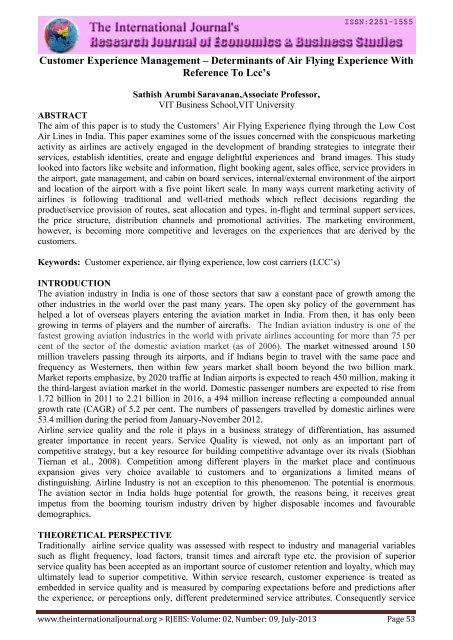Research Journal of Economics & Business Studies - RJEBS - The ...
Research Journal of Economics & Business Studies - RJEBS - The ...
Research Journal of Economics & Business Studies - RJEBS - The ...
You also want an ePaper? Increase the reach of your titles
YUMPU automatically turns print PDFs into web optimized ePapers that Google loves.
Customer Experience Management – Determinants <strong>of</strong> Air Flying Experience With<br />
Reference To Lcc’s<br />
Sathish Arumbi Saravanan,Associate Pr<strong>of</strong>essor,<br />
VIT <strong>Business</strong> School,VIT University<br />
ABSTRACT<br />
<strong>The</strong> aim <strong>of</strong> this paper is to study the Customers’ Air Flying Experience flying through the Low Cost<br />
Air Lines in India. This paper examines some <strong>of</strong> the issues concerned with the conspicuous marketing<br />
activity as airlines are actively engaged in the development <strong>of</strong> branding strategies to integrate their<br />
services, establish identities, create and engage delightful experiences and brand images. This study<br />
looked into factors like website and information, flight booking agent, sales <strong>of</strong>fice, service providers in<br />
the airport, gate management, and cabin on board services, internal/external environment <strong>of</strong> the airport<br />
and location <strong>of</strong> the airport with a five point likert scale. In many ways current marketing activity <strong>of</strong><br />
airlines is following traditional and well-tried methods which reflect decisions regarding the<br />
product/service provision <strong>of</strong> routes, seat allocation and types, in-flight and terminal support services,<br />
the price structure, distribution channels and promotional activities. <strong>The</strong> marketing environment,<br />
however, is becoming more competitive and leverages on the experiences that are derived by the<br />
customers.<br />
Keywords: Customer experience, air flying experience, low cost carriers (LCC’s)<br />
INTRODUCTION<br />
<strong>The</strong> aviation industry in India is one <strong>of</strong> those sectors that saw a constant pace <strong>of</strong> growth among the<br />
other industries in the world over the past many years. <strong>The</strong> open sky policy <strong>of</strong> the government has<br />
helped a lot <strong>of</strong> overseas players entering the aviation market in India. From then, it has only been<br />
growing in terms <strong>of</strong> players and the number <strong>of</strong> aircrafts. <strong>The</strong> Indian aviation industry is one <strong>of</strong> the<br />
fastest growing aviation industries in the world with private airlines accounting for more than 75 per<br />
cent <strong>of</strong> the sector <strong>of</strong> the domestic aviation market (as <strong>of</strong> 2006). <strong>The</strong> market witnessed around 150<br />
million travelers passing through its airports, and if Indians begin to travel with the same pace and<br />
frequency as Westerners, then within few years market shall boom beyond the two billion mark.<br />
Market reports emphasize, by 2020 traffic at Indian airports is expected to reach 450 million, making it<br />
the third-largest aviation market in the world. Domestic passenger numbers are expected to rise from<br />
1.72 billion in 2011 to 2.21 billion in 2016, a 494 million increase reflecting a compounded annual<br />
growth rate (CAGR) <strong>of</strong> 5.2 per cent. <strong>The</strong> numbers <strong>of</strong> passengers travelled by domestic airlines were<br />
53.4 million during the period from January-November 2012.<br />
Airline service quality and the role it plays in a business strategy <strong>of</strong> differentiation, has assumed<br />
greater importance in recent years. Service Quality is viewed, not only as an important part <strong>of</strong><br />
competitive strategy, but a key resource for building competitive advantage over its rivals (Siobhan<br />
Tiernan et al., 2008). Competition among different players in the market place and continuous<br />
expansion gives very choice available to customers and to organizations a limited means <strong>of</strong><br />
distinguishing. Airline Industry is not an exception to this phenomenon. <strong>The</strong> potential is enormous.<br />
<strong>The</strong> aviation sector in India holds huge potential for growth, the reasons being, it receives great<br />
impetus from the booming tourism industry driven by higher disposable incomes and favourable<br />
demographics.<br />
THEORETICAL PERSPECTIVE<br />
Traditionally airline service quality was assessed with respect to industry and managerial variables<br />
such as flight frequency, load factors, transit times and aircraft type etc. the provision <strong>of</strong> superior<br />
service quality has been accepted as an important source <strong>of</strong> customer retention and loyalty, which may<br />
ultimately lead to superior competitive. Within service research, customer experience is treated as<br />
embedded in service quality and is measured by comparing expectations before and predictions after<br />
the experience, or perceptions only, different predetermined service attributes. Consequently service<br />
www.theinternationaljournal.org > <strong>RJEBS</strong>: Volume: 02, Number: 09, July-2013 Page 53
















